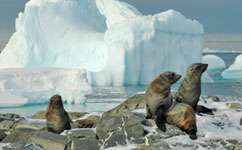Dead seals serve conservation boost

Scientists have used genetic testing on animals that died of natural causes for the first time, potentially boosting efforts to save endangered species.
They tested nine male Antarctic fur seals found on Bird Island in the South Atlantic. Most had died from infections to wounds sustained in battle for the rights to females. The study was published in the journal BMC Genomics.
They hope the trick could now be used on endangered animals, providing valuable information towards their conservation while removing the need for sacrificing individuals.
Investigating genes can provide scientists with vital clues about an animal's chances of survival in a rapidly changing environment.
'In many wild animal populations that are subject to natural and sexual selection, genes can be an important predictor of a given individual's fitness,' says Dr Joe Hoffman of Bielefeld University, the study's lead author.
'For example, animals with high genetic diversity are almost universally found have increased survivorship, carry fewer parasites and achieve greater reproductive success,' he says.
The team used state-of-the-art technology to de-code genetic transcripts, tiny molecules that carry all the instructions for life in living cells.
To build a full picture of an animal's genes, scientists need to take transcripts from as many of their organs as possible.
'This usually means that animals need to be sacrificed,' explains Hoffman. 'Something that is clearly undesirable, particularly when we are working to protect species.'
'Our study is important because we've been able to sidestep this issue by harvesting transcripts from animals after they have already died of natural causes.'
Some of the seals had been dead for up to 30 hours and scientists were worried that their transcripts might be contaminated with the instructions for cell death.
'Fortunately, this wasn't the case,' says Hoffman. 'Fewer than three per cent of transcripts showed similarity to genes known to be involved in cell death.'
It is not yet clear whether the technique could be used for animals that have been dead for longer or those that live in warmer climates and decompose more quickly, but Hoffman hopes the study will now spark similar work on endangered species.
More information: Hoffman, J., Thorne, M., Trathan, P., and Forcada, J. Transcriptome of the dead: charactersisation of immune genes and marker development from necropsy samples in a free-ranging marine mammal, BMC Genomics, 2013, doi:10.1186/1471-2164-14-52
Journal information: BMC Genomics
Provided by PlanetEarth Online
This story is republished courtesy of Planet Earth online, a free, companion website to the award-winning magazine Planet Earth published and funded by the Natural Environment Research Council (NERC).


















